
A Detailed Guide on Faking Your Location in Mozilla Firefox On Samsung Galaxy A15 5G | Dr.fone

A Detailed Guide on Faking Your Location in Mozilla Firefox On Samsung Galaxy A15 5G
Mozilla Firefox is one of the most famous browsers known for its security. Like other browsers, it also tracks your location and shares it with websites. Although Firefox asks for your permission before sharing your location, it can still be a privacy concern for many people. For many reasons, disabling your location is disadvantageous, so Firefox spoof location can resolve your concerns.
It is not hard to change or spoof your location in Mozilla Firefox. Stick with this article to learn different ways to fake a location in Firefox on devices.

Part 1: Preparations Before Spoofing Your Location in Firefox
Before starting with Firefox location spoof, you must be aware of how the platform and websites determine your location. There are many ways a browser can detect your location. It includes services like IP addresses, GPS tracking, Wi-Fi, and Bluetooth. The main tool browsers and websites use to determine your location is HTML5 Geolocation API.
1. Basic Understanding of the HTML5 Geolocation API
Basically, a browser API called HTML5 Geolocation API is used by websites and browsers to detect a user’s location using longitude and latitude coordinates. It is strictly based on user permissions for detecting location. That means you will receive a permission prompt whenever a website or browser uses it to detect your location. If you refuse the permission, they can’t use this API for location determination.
2. How Does HTML5 Geolocation Work?
HTML5 Geolocation determines your location using the longitude and latitude coordinates with the help of GPS. If your device doesn’t have GPS tracking, it uses Wi-Fi and cell tower signals to detect the Samsung Galaxy A15 5G device’s location. The location detected by HTML5 Geolocation is highly accurate with accuracy up to street level. Due to its high precision in locating users, it can create privacy issues for users.
Part 2: How to Fake Your Location in Mozilla Firefox on Computers
Many ways are available for you to fake or disable your desktop location in Mozilla Firefox to address your privacy concerns. You can either disable or change the location in the browser or use a third-party app or extension. Below, we have explained the three most common ways to fake or disable your location in Firefox.
Method 1: Disable Geolocation in Firefox
If you want to stop websites from accessing your location from Mozilla Firefox, you can disable the geolocation feature using Firefox Settings. The process to disable your location in Mozilla Firefox is covered using these steps:
Step 1: Open Mozilla Firefox on your computer to disable its location. Click the “Three Vertical Bars” icon to select “Settings.” Now, tap “Privacy & Security” from the left sidebar and navigate to “Permissions.”

Step 2: Click “Settings” in front of “Location” to manage the location settings. It will open a window with a list of all the websites that can access your location. Depending on your needs, you can choose between “Remove Web Site” or “Remove All Web Sites” to remove their location access.

Step 3: If you want to block the websites from accessing your location indefinitely, you can select the “Block new requests asking to access your location” option. Once selected, click “Save Changes” to disable your geolocation on Firefox.

Method 2: Manually Change Your Firefox Location
Disabling your location on Mozilla Firefox can stop websites from accessing your location. It also means websites with location-based services will no longer work. That’s why it is better to spoof the location on Firefox rather than disabling it. Firefox allows you to manually change your location using its advanced settings. The steps required for this process are given below:
Step 1: Once Mozilla Firefox is open, type “about:config” and press Enter. You will see a warning screen as you modify advanced settings. You have to click on the “Accept the Risk and Continue” button to proceed further.

Step 2: First search for “Geo.enabled,” and when it appears, toggle its value from “True” to “False” to disable geolocation. To spoof your location, search for “geo.provider.network.url” and press the “Pen” icon to edit it.

Step 3: You can enter your desired location using its latitude and longitude coordinates. The format to enter your location coordinates should be:
“data:application/json,{“location”: {“lat”: LATITUDE VALUE, “lng”: LONGITUDE VALUE}, “accuracy”: 27000.0}.”
Once done, your geolocation will be changed to your desired location.

Method 3: Use The Location Guard Firefox Extension
Another way you can protect your location from websites is to use the “Location Guard “ add-on in Mozilla Firefox. It is generally recognized as an extension, also available in the Add-Ons Store of Firefox. The steps to add “Location Guard” and use it to alter your location are following:
Step 1: Click on the “Three Vertical Bars” icon from the top left corner of your Firefox and select “Add-ons and themes.” Tap “Extensions” from the left sidebar and search for “Location Guard” in the Add-Ons Store. Once located, click “Add to Firefox” to add it to your browser.

Step 2: You can choose between two options to protect your location’s privacy. Using the “Privacy Levels” option, you can select a privacy level and location range to add noise when a website tries to locate you. It stops websites from detecting your accurate location, though they can still locate the general area.

Step 3: Using its “Fixed Location” feature from the left sidebar, you can change your location. Here, select any location from the map by placing the “Marker” on it to change your browser’s location.

Part 3: How to Fake Your Location in Mozilla Firefox on Phones
It is not only on computers where you can use Firefox fake location but also on smartphones. You can easily disable or change your Firefox location on your iOS or Android device. Three different methods to disable or change the location in Mozilla Firefox are summarized below:
Method 1: Disable Geolocation Sharing on the Firefox Browser
If you use the Firefox browser on your phone, it allows you to disable your location using a couple of simple steps. Disabling location services for the Firefox browser differs on Android and iOS devices. A detailed step-by-step process for disabling location is given below for both platforms:
On Android
Step 1: Open the Firefox browser on your phone and press the “Three Dots” icon from the bottom right corner. Select “Settings” from the menu and navigate to the “Privacy and Security” section.
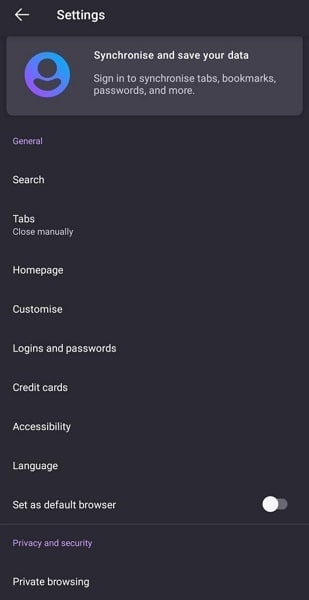
Step 2: Now, tap “Site Permissions” and select “Location.” In the “Location” option, select “Blocked” to disable the location access on the Firefox browser.

On iPhone
Step 1: On your iPhone, open “Settings” and scroll down to “Firefox.” After locating the app, select it and press “Location” on the next screen.

Step 2: In the “Location” menu, you can select “Never” to completely disable the location access for the Firefox browser. To only stop Firefox from detecting your accurate location, turn off the toggle of the “Precise Location” option.

Method 2: Spoof Your Location in Firefox Using Dr.Fone - Virtual Location
Nowadays, many websites work with the help of location-based services. Disabling geolocation from the Firefox browser means they won’t work. It means you need a tool that can change your Firefox location without affecting your favorite platforms.
Wondershare Dr.Fone - Virtual Location provides you with an excellent way to do Firefox location spoofing. You will not have to worry about websites or apps detecting your location as fake when using this tool.
Dr.Fone - Virtual Location
1-Click Location Changer for both iOS and Android
- Teleport from one location to another across the world from the comfort of your home.
- With just a few selections on your computer, you can make members of your circle believe you’re anywhere you want.
- Stimulate and imitate movement and set the speed and stops you take along the way.
- Compatible with both iOS and Android systems.
- Work with location-based apps, like Pokemon Go , Snapchat , Instagram , Facebook , etc.
3981454 people have downloaded it
Main Features of Dr.Fone - Virtual Location
- Dr.Fone - Virtual Location allows you to play location-based games. It includes games like Pokémon Go, Minecraft Earth, and Jurassic World Alive, all from the comfort of your bed.
- If you use a dating app like Tinder or Bumble, you can increase your likes and matches using this tool.
- You can bypass the geo-restriction of apps and enjoy their content with the tool’s help.
Steps Required for Spoofing Location in Firefox via Dr.Fone - Virtual Location
Using Dr.Fone- Virtual Location to spoof your location in Mozilla Firefox is simple and quick. You will need to install Dr.Fone on your computer and follow these steps for location spoofing:
Step 1: Install Dr.Fone on Your System
Download and install Dr.Fone on your computer and connect your phone to it. Access Dr.Fone, select “Virtual Location,” and click “Get Started” on the next screen to begin the process.

Step 2: Activate the Teleport Mode on Dr.Fone
After clicking “Get Started, “ a map will open where you must select your original location. It can be done using the “Center On” icon from the right sidebar. To choose your fake location, you will need to activate “Teleport Mode” from the top right corner.
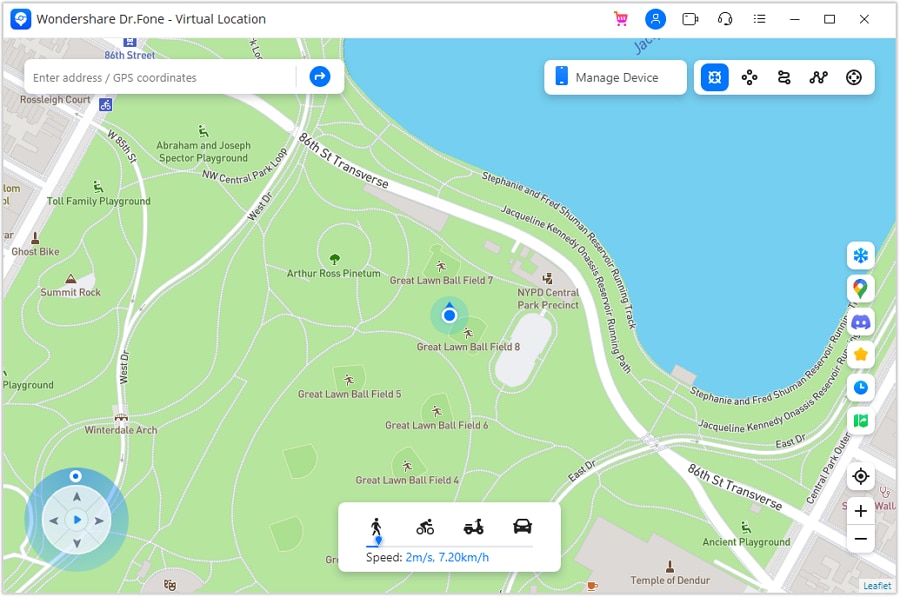
Step 3: Spoof Your Location in Firefox
Enter your desired fake location in the provided space and press “Go” once the mode is activated. It will take you to the entered location, where you need to select “Move Here” to complete the process. You can confirm the location spoof by opening any location-based app on your phone.
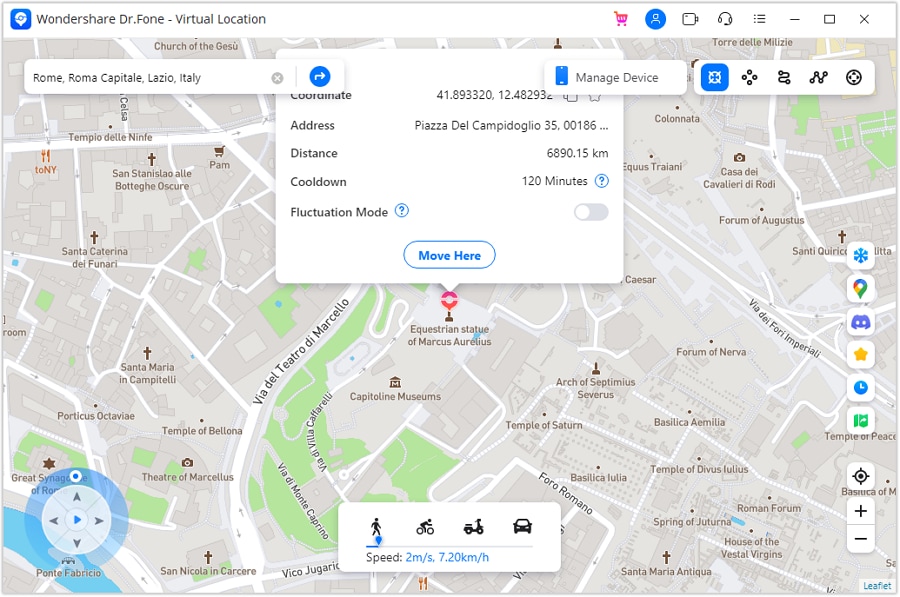
Method 3: Change Your Location in Firefox Using ExpressVPN
Browsers like Mozilla Firefox tracks your location by using your IP address. You can use a VPN to spoof your IP location to protect your actual location from websites. ExpressVPN is a VPN that is available for both Android and iOS devices. You can use these steps to change your location using ExpressVPN:
Step 1: Install ExpressVPN on your phone and create an account for it. If you are already a user of ExpressVPN, then log in with your account.
Step 2: Select your desired fake location from the “Smart Location” tab after logging in. Once a location is selected, press “Connect” to change to the desired fake location.

Conclusion
In today’s digital world, you have to compromise your privacy to some extent. However, it doesn’t mean that you should not try to use tools available to you to protect your privacy to the limit. Dr.Fone - Virtual Location solves your concerns regarding location sharing with ease. With this tool, you can fake location in Firefox and still enjoy all the features and services offered by location-based websites and apps.
How To Simulate GPS Movement With Location Spoofer On Samsung Galaxy A15 5G?
When you are playing location-based games like Pokemon Go, you might need to simulate GPS movement to catch more Pokemon. To do this, you can use the GPS movement feature of Wondershare Dr.Fone - Virtual Location . This feature allows you to simulate GPS movement between two or multiple spots on the map. Here’s how you can do it:
Part 1: Simulate Movement Along a Route (One-Stop Route)
You can set up a one-stop route when mocking locations fake with Dr.Fone - Virtual Location. This particular feature helps users to set up looping or round trips within a specific location. To perform the steps for simulating movement, look ahead for a better understanding:
Step 1Access One-Stop Route Function
Once you launch Wondershare Dr.Fone - Virtual Location and connect your smartphone successfully, proceed to select the One-Stop Route function from the top-right section. The function is represented by the third icon from the left in the section. While you have already teleported to another location or are using your current location, you can tap anywhere on the map to set your destination location.
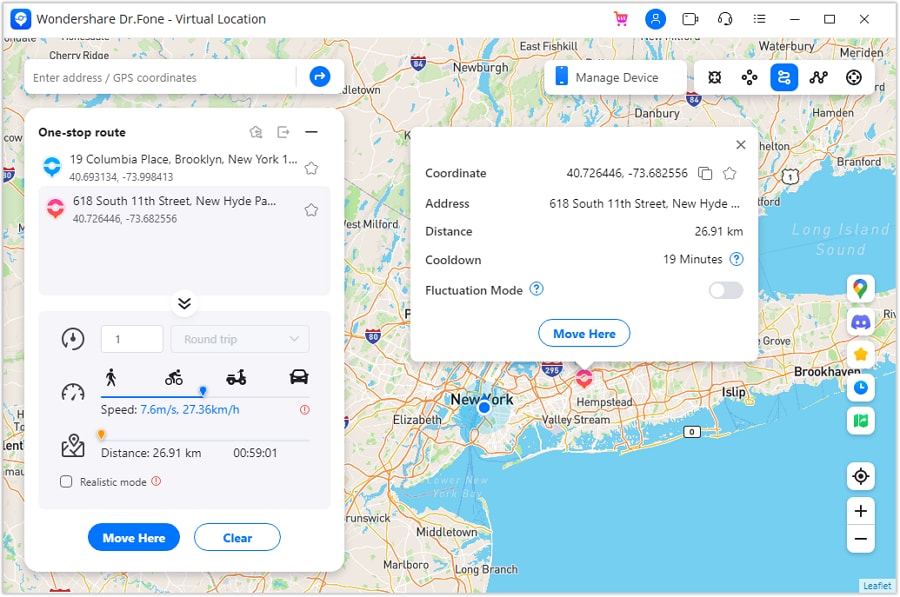
Step 2Define Simulation Parameters
Enter a number to define how many times you want to go back and forth, and select whether you want a Round trip or a Loop trip. Drag the slider on the speed option to set how fast you want to walk. Proceed to click Move Here on the bottom to start the movement simulation.
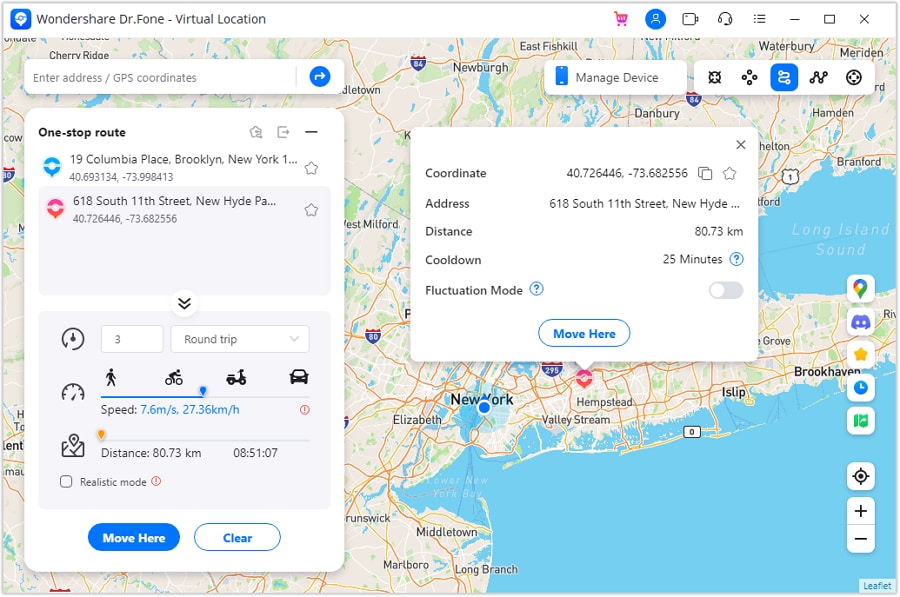
Step 3Start Simulation Movement
The respective simulation starts, and you can see your position is moving on the map with the speed you set. If you wish to hold the simulation, click Pause or tap Clear to revert to your original state.
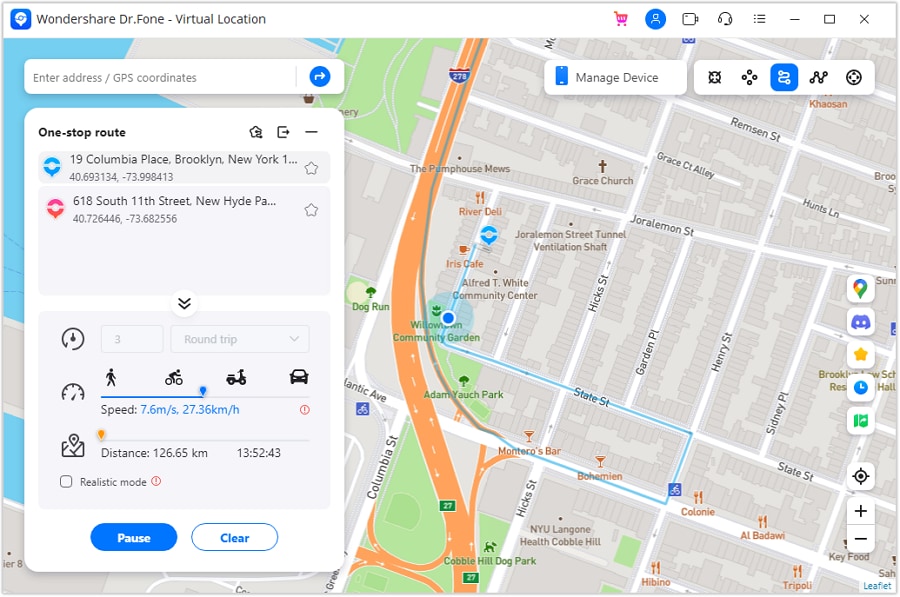
Part 2: Simulate Movement Along a Route (Multi-Stop Route)
You can try the multi-stop mode if you want to pass by multiple places along a route on the map. Learn how it is done when you are trying to **spoof location on Android/**iOS:
Step 1Start Multi-Stop Route and Set Parameters
Activate the Multi-Stop Route mode from the top-right section next to the One-Stop Route mode. After activating the mode, set multiple spots on the map by clicking your required place. Define the number of trips and speed. Click Start Moving to initiate the process.
Note: Select the spots along a specific road to prevent the game developer from thinking you are cheating.
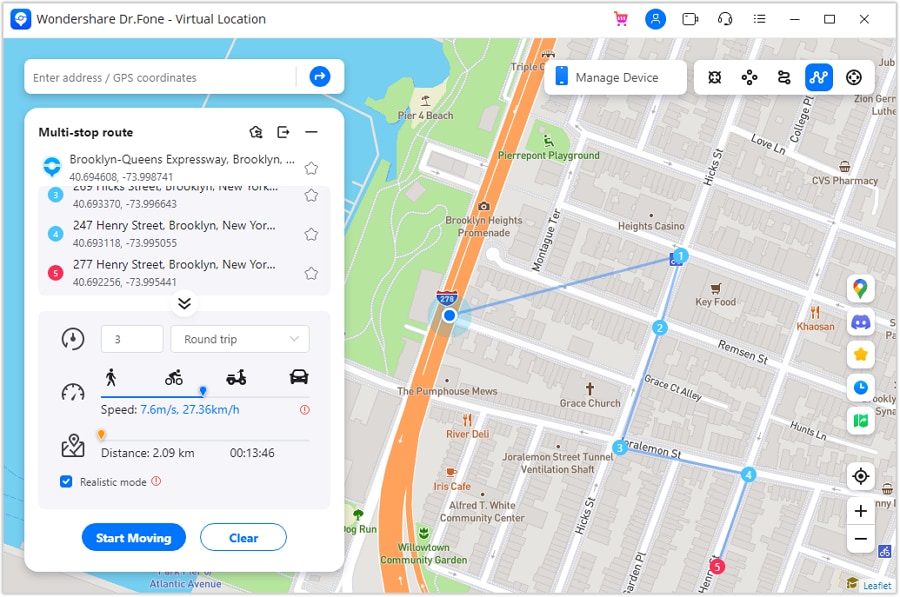
Step 2View Multi-Stop Route Movement
As the simulation starts, click Pause at any instance where you want to stop the simulation. You can also Clear all settings if required.
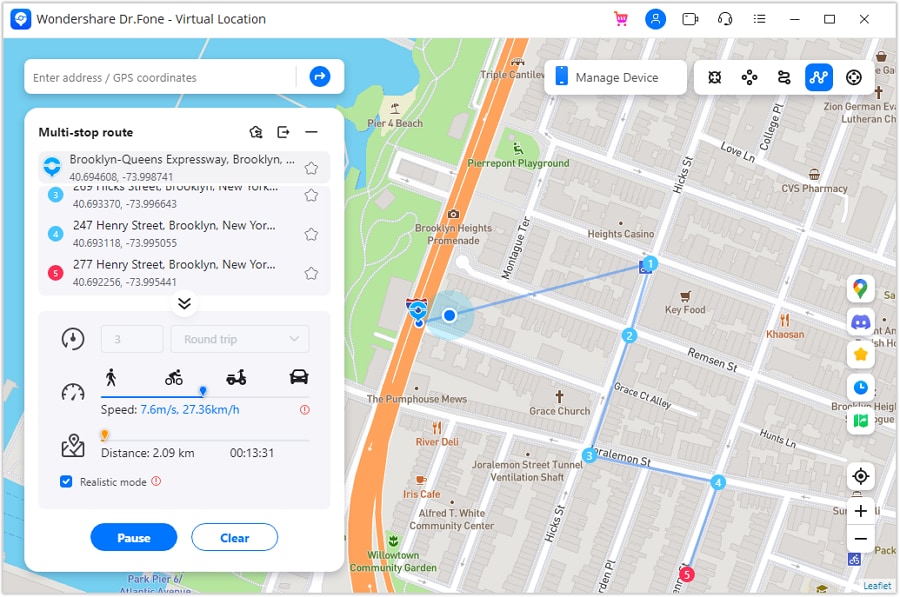
Part 3: Use Joystick for More Flexible GPS Control (Joystick Movement)
Dr.Fone has integrated the joystick feature into the Virtual Location program to spare 90% of the labor for GPS control. You can always find the joystick on the lower left part in teleport mode. And you can also click the joystick button in the upper right (the 5th one) to use the joystick feature.
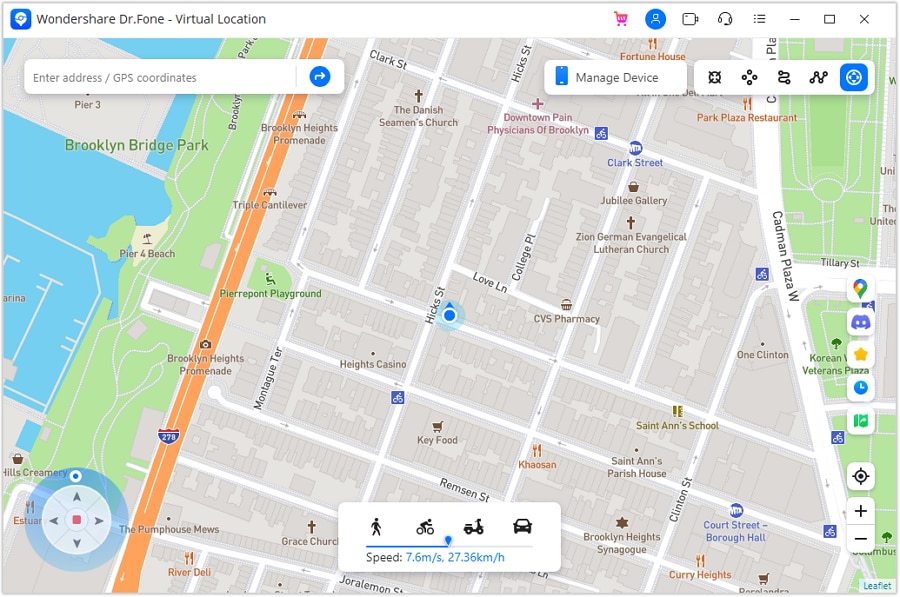
The joystick, like one-stop route or multi-stop route modes, aims to facilitate GPS movement on the map. But what’s better? The joystick lets you move on the map by changing directions in real time. Here are the two main scenes where you will definitely love the joystick.
- Automatic GPS movement: Click the Start button in the middle, and the automatic movement starts. Then just change the directions as you like by 1) clicking the left or right arrows, 2) dragging the spot around the circle, 3) pressing keys A and D on the keyboard, or 4) pressing keys Left and Right on the keyboard.
- Manual GPS movement: Move forward by constantly clicking the Up arrow in the program and long-pressing the key W or Up on the keyboard. Reverse by constantly clicking the Down arrow, or long-pressing the key S or Down on the keyboard. You can also tweak the directions using the four ways above before moving forward or reverse.
What is Geo-Blocking and How to Bypass it On Samsung Galaxy A15 5G?
Have you ever entered a website and can’t access it because it is unavailable in your area? This is what geo-blocking means. If you want to know more about geo-blocking, you have come to the right article. This article provides the definition, symbols, function, type, and how to bypass a geo-blocked site.
Encryption is often used in geo-blocking as a means of protecting material that is restricted to users in just certain locations. In its long existence, the method has been met with several obstacles. These obstacles will be discussed in the next sections!

Part 1. What is Geo-Blocking?
This section will give you the definition of geo-blocking. It will also show how websites inform viewers that they are in geo-blocking areas.
Definition of Geo-Blocking
Geo-blocking is the practice of restricting online access to certain users depending on where in the world they happen to be physically located. Telecommunications firms, websites, and other content providers and intellectual property owners often use this method for copyright protection. To monitor and enforce geo-blocks, databases that map out IP addresses’ geographical locations are often employed.
Understanding the Main Symbols and Elements
You sometimes can’t access a site because it isn’t available in your area. This is the main element carried by geo-blocking.
Every online-surfing tool has a unique identifier called “IP address”. The address can identify the Samsung Galaxy A15 5G devices’ geographical location. When users access a website, their devices send their IP addresses to the online servers. The servers read if the IP addresses are included in the allowed list and determine whether to allow the visitors to view the content.
The visitors usually know they are geographically limited through the website’s displayed outcomes, a poster indicating that the service is unavailable in the location. Take the geo-banned access by Airbnb as an example below.
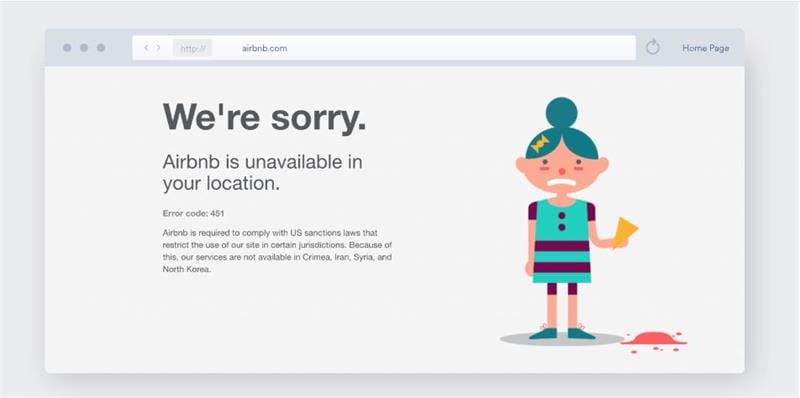
Although Airbnb has been criticized for posing a threat to the availability of low-cost lodging in metropolitan areas, it has proven to be a useful resource for travelers. However, not everyone can use it; for instance, it is unavailable in Iran due to US sanctions.
Part 2. How Does Geo-Blocking Work?
When a firm, rather than a government, is responsible for geoblocking, IP addresses are often the first line of defense. Your IP address is like a street address, revealing where you live.
IP addresses are numerical identifiers that distinguish each machine on the internet. Your computer’s IP address is sent to the server of the website you visit so that it may supply the required data.
You’ll be assigned an IP address when you sign up for an Internet Service Provider. It is possible to pinpoint the location of your device using its IP address, albeit the degree of precision may vary. Websites use the IP address to determine whether you can read their content. They will thus refuse your request if you are using an IP address that’s not on their approved list.
Part 3. Common Types of Geo-blocked Content
The difficulty stems from legal hurdles, including copyrights, licenses, and territorial disputes. Certain streaming services may not make all of their offerings accessible in all regions, or a major online shop may restrict some of their offerings to customers in just one geographic area.
Youtube
Users who upload videos can restrict access to them in certain countries. This nearly usually indicates that a business has chosen that you shouldn’t be able to see a video because of where you are located.

Spotify
You may be trying to find a method to unblock Spotify because you want to listen to unavailable music in your country or because the app has been prohibited in your area.

Live Sports
Big events may be aired exclusively by one company, which means you may be forced to pay to access certain material or go through annoying subscription hoops.

Pandora
Do you want to tune in to this online radio and music station? You can’t access it anywhere in Europe because of a regional firewall.

Porn sites
Artists from porn sites can now geo-block their movies, much like YouTube users do. Some porn sites have been outlawed in several countries, including Egypt and Pakistan, where the vast majority of the population resides.

Amazon
Amazon Prime geo-blocks other services as well as its streaming content. Games, ebooks, software, audiobooks, and other digital materials like TV and movies may be licensed and copyrighted. Amazon Prime prevents certain VPN IPs from accessing foreign content, including Netflix.

Part 4. Tips to Bypass Geo-Blocking
While certain sites may be blocked in your country, there are still methods to access the full functionality of the web. What exactly are they, and how do you go about getting them? Here’s more reading material.
Method 1. Use Smart Domain Name System (DNS)
Clever DNS can evade geoblocking if your smart TV, streaming box, or gaming console doesn’t support VPNs or proxy servers. Some home routers can generate VPN connections, but not all.
By changing your DNS address, clever DNS may alter your device’s virtual location. Smart DNS replaces your Internet provider’s DNS server. Netflix.com’s IP is not netflix.com. You’ll acquire the smart DNS provider’s transparent DNS proxy IP. Netflix thinks you’re in the US since this proxy server is.
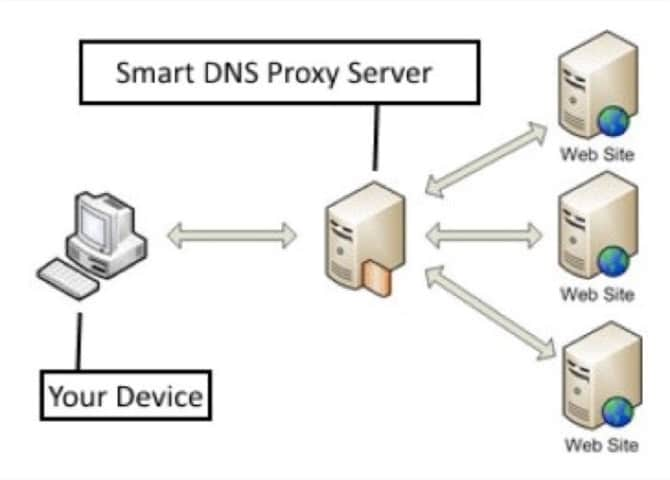
Method 2. Connect to Proxy Servers
Rather than connecting you directly to the server housing the material you want, a proxy server functions as an intermediary. A proxy server does what its name implies: it acts on your behalf to get access to the data and then forwards it to you. Proxy servers, especially those in foreign countries, may be used to get around geographical restrictions.
Depending on the kind of proxy server you use, you may or may not be able to conceal your IP address when surfing the web. Proxy servers are available online and may be accessed from any web browser. Setting up a proxy server is easy, but your activity may still be vulnerable since proxies don’t secure your data.
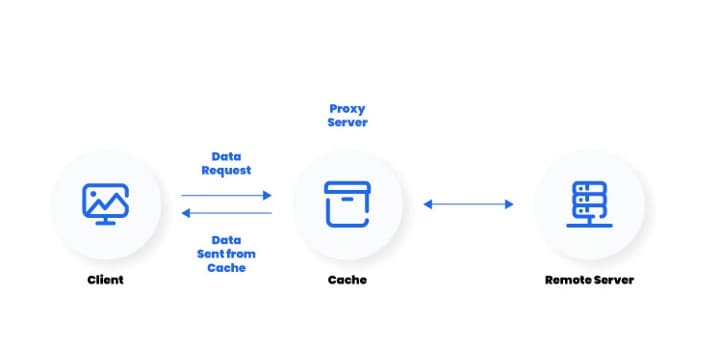
Method 3. Use the Tor Browser
In addition to using a VPN, you may use the anonymous Tor browser. The Tor browser links to the Tor network, a collection of computers that collaborate to conceal your online footprint by relaying your traffic via several intermediary nodes.
Tor employs a technique called “onion routing” to conceal its users’ identities. Since more time is required to traverse these additional levels, your internet speed may suffer as a consequence.
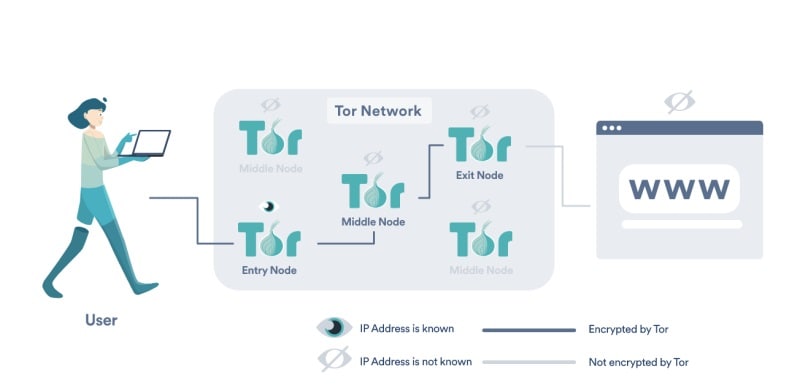
Method 4. A Good VPN Connection
A virtual private network (VPN) may hide your online identity and protect your data by encrypting your connection. VPNs allow you to get around geographically restricted material by redirecting your connection via a server in another country. This will allow you to connect to VPN servers in other countries, such as the United States, the United Kingdom, or Australia.
With effective VPN tools , you can surf the web anonymously, unblock geo-blocked content, and watch your favorite programs abroad. There are several advantages to utilizing a VPN, particularly when you travel or use public Wi-Fi, and they are simple to set up.

Part 5. FAQs About Geo-Blocking
Here are the answers to four questions that you might ask about geo-blocking.
1. Is Geo-Blocking Legal?
Yes. It’s legitimate. Limiting access to websites and services based on a user’s location is lawful. This practice is routinely used in nations like China to prevent citizens from seeing politically sensitive material. Legal arrangements, such as licensing agreements, may also be enforced by geo-blocking.
2. Is Bypassing Geo Blocking Illegal?
It depends. Depending on the situation, the nation, the purpose of the use, and the technique used, geo-blocking circumvention may be against the law. Copyright regulations prohibit users from accessing material beyond its designated location, yet many providers are reluctant to penalize users for doing so.
3. What’s the Difference Between Geo-Fencing and Geo-Blocking?
Geo-fencing is to create digital fences on which to base real-world judgments about where to go. One may draw a boundary around it using longitude and latitude lines on a map to easily establish who is permitted inside a certain region. Restricting access to material based on a user’s physical location is called “geo-blocking.”
4. Is Geo-Restricted the Same as Geo-Blocking?
They are the same. Restricting a user’s ability to access certain online resources depending on their location is known as geo-blocking or geo-restriction. To safeguard their license agreements, foreign media streaming firms often use the practice of geo-blocking.
Conclusion
For several reasons, media and content producers use geo-blocking. Although geo-blocking is unlikely to ever go out of style, there are techniques to circumvent it. Use a virtual private network (VPN) to bypass geo-restrictions on the material you want to watch. Using a Virtual Private Network (VPN), a proxy server, the Tor network, etc., your online location may be hidden or masked.
Geo-blocking controls. It’s both useful and abused. Website banning discriminates and manipulates. Geography may be annoying and frustrating. Sadly, they may always be in style. You don’t have to tolerate them!
Also read:
- [New] Dissecting the Advantages of HDR TVs Like Aurora for 2024
- [New] In 2024, JollyJingles Top Sites to Stream Laugh-Rich Rhythms
- [Updated] Reactivate Windows Photo Viewer with Ease (Win 11) for 2024
- 3 Ways to Change Location on Facebook Marketplace for Vivo T2 5G | Dr.fone
- 3 Ways to Fake GPS Without Root On OnePlus Ace 2V | Dr.fone
- 3uTools Virtual Location Not Working On Oppo A58 4G? Fix Now | Dr.fone
- 3uTools Virtual Location Not Working On Realme Narzo 60 5G? Fix Now | Dr.fone
- 4 Methods to Turn off Life 360 On Xiaomi Redmi 13C without Anyone Knowing | Dr.fone
- 8 Solutions to Fix Find My Friends Location Not Available On Xiaomi Redmi A2+ | Dr.fone
- A Detailed Guide on Faking Your Location in Mozilla Firefox On Nokia C12 Pro | Dr.fone
- A Detailed Guide on Faking Your Location in Mozilla Firefox On Tecno Camon 20 Premier 5G | Dr.fone
- Fixing Lower FPS in Forza Horizon 5: Tips and Tricks
- Google's Security Challenge: Unmasking Fraudulent Search Advertisements by Cybercriminals
- How To Stop Unexpected Display Glitches on Your Windows 10 Computer
- Simplify Account Management in Windows 11 with YL Computing's Comprehensive Strategies and Tricks
- Updated 5 Tips About YouTube Shorts to Grow Your Business for 2024
- Video File Repair - How to Fix Corrupted video files of OnePlus Ace 2?
- Title: A Detailed Guide on Faking Your Location in Mozilla Firefox On Samsung Galaxy A15 5G | Dr.fone
- Author: Mia
- Created at : 2025-02-16 23:05:19
- Updated at : 2025-02-19 23:48:43
- Link: https://location-fake.techidaily.com/a-detailed-guide-on-faking-your-location-in-mozilla-firefox-on-samsung-galaxy-a15-5g-drfone-by-drfone-virtual-android/
- License: This work is licensed under CC BY-NC-SA 4.0.